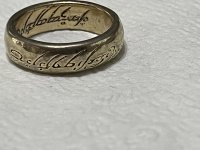You are using an out of date browser. It may not display this or other websites correctly.
You should upgrade or use an alternative browser.
You should upgrade or use an alternative browser.
Garrett Sea Hunter Mark II Info Needed
- Thread starter bigscoop
- Start date
Tom_in_CA
Gold Member
- Mar 23, 2007
- 13,837
- 10,360
- 🥇 Banner finds
- 2
- Detector(s) used
- Explorer II, Compass 77b, Tesoro shadow X2
Yes it loves iron, all PI machines love iron. You buy a PI to get deeper than a VLF detector
and you should dig every beep, not all iron sounds are iron, not only with the SH, but
others as well. If the beach your hunting has to much trash to suit you, move to a
different one. Big mistake using disc. on a beach. Do your own depth testing on your
area beaches to see how deep it will pickup different objects. Every beach is different!
What's more important is the depth to the base under the sand, If your trying to find
the good stuff, you need to know if your machine can reach that level. If your trying to
find gold rings and such you need to hunt over a base no deeper than 2 1/2 feet deep.
As the 14 x 10 loop is as large as you can get for the SH, that's about the limit it will
detect a ring. And yes I have one and I also have a Minelab SD2200d with different
size coils from 5 x 7" to 18" and it can go beyond 2 1/2 ft. and find rings.
D-tex, re.: the "deeper" aspect of pi vs vlf: In the old days this was an accurate statement. But nowadays there are discriminators that have closed that gap somewhat. I mean for example, if someone's gotten proficient with the Sov/Wot combo, they can get coins to well beyond a foot with ease (14" or so anyhow). And that's pretty close to coin-depths on most beach pulse machines nowadays, right? To the extent that some pulse machines can do 1.5 ft. (or ... heck ... there's even nugget pulse machines that can push 2 ft. !) when you start talking sensitivity levels like that, you're talking about going insane. Like with teensy bread-twisties, birdshot, staples, etc... But if restricting the conversation to regular beach pulse machines: No. That gap is now very close. Yes the pulse has a slight edge, and yes it goes through nastier minerals (if minerals were even an issue at one's particular beach). But for a lot of situations, the depth difference is now negligable.
Interesting that you say: "If the beach your hunting has to much trash to suit you, move to a different one." But what do you do if THAT beach is the one putting out the goodies ? I can think of many examples where .. yes ... the beach was FULL of nails or odd-ball stuff after a storm erosion. And that was EXACTLY where we wanted to be. NO WAY would we simply "leave for a cleaner beach" because this one had "too much trash". To us, that's exactly where we want to be. Because when mother nature has scoured down that deep (bringing to the top 70 or 100 yrs. of iron), is EXACTLY the place where the coins/conductors will also be.
And you say: " Big mistake using disc. on a beach." Well yes and no. It depends on what/where/when you mean that. If you mean that someone is making a mistake for knocking out iron, then I'd have to disagree with you. There's lots of environments where being a hero and digging all the nails ("lest you miss a tinsel thin chain") can be an exercise in insanity. Or if you mean to eliminate foil and tabs, then yes, I'd agree with you. But another thing to take into account (although it rarely happens), is when targets become SO thick, that you litterally don't want to dig high conductive coins at all. Yup, kiss dimes, pennies, quarters, etc... goodbye (even if silver), and go for only the mids and lows. I've actually seen conditions this good, where we "gamed the system" and angled for the mids and lows to up our gold count. This was because we knew full well that our zone was going to sand in within a few days, and there was simply no way to "get it all".
I think you're accustomed to Bay-watch or Hawaii style touristy clean beaches. In some zones like that, then yes, there are advantages to having a pulse, digging all, etc....
bigscoop
Gold Member
- Jun 4, 2010
- 13,373
- 8,689
- Detector(s) used
- Older blue Excal with full mods, Equinox 800.
- Primary Interest:
- All Treasure Hunting
- Thread starter
- #22
Again, iron is not going to be an issue where I'm planning to hunt. Right now my areas beaches have 2 - 3 feet of very fine summer overburden so I'm just hoping to catch some of those goodies on the way down while using the smallest coil possible in order to reduce the drag at the end of the stick. if mother nature comes along and sweeps away some of this sand so I can once again hunt over some hardpack of any kind then I have other machines more suited to that trashier task.
davest
Silver Member
- Nov 5, 2007
- 3,265
- 1,273
- Detector(s) used
- titan 3000xd/seahunter mk ll/Ace 250/whites 6000XL Pro
- Primary Interest:
- All Treasure Hunting
I have 5 years on my SH Mkll, I have sent it back to Garrett 5 times for service due to falsing. I've purchased 4 coils based on their recommendation, had a bulkhead fitting leak one time, and have hunted with the 10 x 14 without much luck. When the fitting leaked they only charged me parts prices, along with new headphones. I've dug enough gold to pay it off 3-4 times,(don't think that was skill), dug enough bobbypins, bottle caps and junk to open a scrap yard. Right now it's hanging on the wall and I'm considering putting it on CL and buying a Sand Shark.
Last time it went in for service I asked that they send me a synopsis of what they found and what they did to repair it. Alas, I didn't get that part.
Would I buy another knowing what I do now. No.
Last time it went in for service I asked that they send me a synopsis of what they found and what they did to repair it. Alas, I didn't get that part.
Would I buy another knowing what I do now. No.
Fletch88
Silver Member
- Mar 7, 2013
- 4,841
- 2,367
- Detector(s) used
-
Garrett ATPro- 8.5x11, 5x8, CORS Fotune 5.5x9.5
Tesoro Silver microMax- 8 donut, 8x11 RSD, 3x18 Cleansweep
Minelab Excalibur ll- 10" Tornado
Minelab CTX 3030
Minelab Xterra 305
- Primary Interest:
- All Treasure Hunting
IMO hardwired is the only way to go with a machine in a salt environment. No matter how much care is taken eventually there will be a problem. The Shark is definitely a very durable setup.
madforclad
Full Member
- May 7, 2014
- 195
- 61
- Detector(s) used
- Minelab eTrac, Minelab X Terra 705, Garrett AT Pro with 5" x 8" coil, Fisher F2, Garrett Pro Pointer, RTG 710 Scoop.
- Primary Interest:
- All Treasure Hunting
Interesting. I agree and would not buy another one knowing what I know now. I just do not get the depth that PI machines are supposedly known for. In addition the wobbly shaft drives me crazy. I'm looking at an Excal now.
davest
Silver Member
- Nov 5, 2007
- 3,265
- 1,273
- Detector(s) used
- titan 3000xd/seahunter mk ll/Ace 250/whites 6000XL Pro
- Primary Interest:
- All Treasure Hunting
BTW, I hunt with the dials set to 1 on disc & barely breaking threshold. I don't use the discreet setting at all, I don't even know what that is on there for.
I have it chest mounted on a set of suspenders to take the weight. If you're gonna be looking for items 24 inches down in any kind of surf you'll need a backhoe with small
holes in the bucket or you'll be dancing around trying to find your target for days. Just last sunday I noticed the new coil I'm using only sounds at the heel in an air test.
Why would that happen? Maybe if you're looking for cannons and large pieces of iron this would make sense.
I have it chest mounted on a set of suspenders to take the weight. If you're gonna be looking for items 24 inches down in any kind of surf you'll need a backhoe with small
holes in the bucket or you'll be dancing around trying to find your target for days. Just last sunday I noticed the new coil I'm using only sounds at the heel in an air test.
Why would that happen? Maybe if you're looking for cannons and large pieces of iron this would make sense.
The Sea Hunter has a reputation for being a very reliable machine. There can be a lemon in any product line, of course, but this seems to be VERY unusual in regards the Sea Hunter. The Mel Fisher group has been using the Sea Hunter since the search for the Atocha began...I think if the machine were in any way unreliable they would have made a change years ago.
I have had a MkII for quite a number of years and it has never been sent in for service and works like a charm. As a matter of fact, I also still own a Garrett XL 500 pulse, the MK II's predecessor, and it still works like a charm as well, though it is not as sensitive as the MK II. I still love the "spacy" UFO type threshold of that machine. I would not recommend the XL 500 for small, low conductive rings, but it is great for finding musket balls and higher conductive targets.
The huge advantge of a PI detector over a VLF is in its ability to ignore mineralization. On wet sand with low mineralization, coil for coil, your Excal in PP will probably beat almost any PI on the market !!! Once you get in the salt water though, the PI will start to shine big time, while the Excal's performance will drop off rapidly.
All this being said, the Sea Hunter is a great machine and very well built. If you are planning on diving or wading past mid calf depth, it probably would be a significant upgrade, especially with the 10x 14 coil.
I disagree completely with the contention that hard wiring is the way to go with an underwater metal detector.
The engineers of the most expensive underwater detectors agree with me.
What hardwiring really does is lower production costs for the manufacturer.
The ability to change coils and headphones is, IMHO, a small price to pay for the small amount of extra maintenance needed to keep your machine in top shape.
Relieving stress on the conection points is the key. In this regard a hardwired detector is just as likely to fail as a detector with a bulkhead fiting. And of course there is cleanliness and silicone. They are indispensible.
I have had a MkII for quite a number of years and it has never been sent in for service and works like a charm. As a matter of fact, I also still own a Garrett XL 500 pulse, the MK II's predecessor, and it still works like a charm as well, though it is not as sensitive as the MK II. I still love the "spacy" UFO type threshold of that machine. I would not recommend the XL 500 for small, low conductive rings, but it is great for finding musket balls and higher conductive targets.
The huge advantge of a PI detector over a VLF is in its ability to ignore mineralization. On wet sand with low mineralization, coil for coil, your Excal in PP will probably beat almost any PI on the market !!! Once you get in the salt water though, the PI will start to shine big time, while the Excal's performance will drop off rapidly.
All this being said, the Sea Hunter is a great machine and very well built. If you are planning on diving or wading past mid calf depth, it probably would be a significant upgrade, especially with the 10x 14 coil.
I disagree completely with the contention that hard wiring is the way to go with an underwater metal detector.
The engineers of the most expensive underwater detectors agree with me.
What hardwiring really does is lower production costs for the manufacturer.
The ability to change coils and headphones is, IMHO, a small price to pay for the small amount of extra maintenance needed to keep your machine in top shape.
Relieving stress on the conection points is the key. In this regard a hardwired detector is just as likely to fail as a detector with a bulkhead fiting. And of course there is cleanliness and silicone. They are indispensible.
Last edited:
Boatlode
Bronze Member
- Mar 30, 2014
- 1,728
- 3,034
- Detector(s) used
-
Tesoro Sand Shark......
Nokta Pulse dive....
Scubapro Jet Fins...................
Mares Puck dive computer.......
Sherwood Silhouette BCD.......
Poseidon Cyklon 300 regulator...
- Primary Interest:
- Shipwrecks
I disagree completely with the contention that hard wiring is the way to go with an underwater metal detector.
The engineers of the most expensive underwater detectors agree with me.
What hardwiring really does is lower production costs for the manufacturer.
In this regard a hardwired detector is just as likely to fail as a detector with a bulkhead fiting.
Wrong, wrong, and wrong. As an engineer, I worked for years in the electronics manufacturing industry. A hardwired connection can be completely sealed, a jack cannot. Stress relief is important, but eventually a jack is going to leak by its very nature.
Also wrong about manufacturing costs. Hand soldering is THE most expensive operation in electronics manufacturing. The labor costs for the hard wiring are way more than the cost of a connector.
Wrong, wrong, and wrong. As an engineer, I worked for years in the electronics manufacturing industry. A hardwired connection can be completely sealed, a jack cannot. Stress relief is important, but eventually a jack is going to leak by its very nature.
Also wrong about manufacturing costs. Hand soldering is THE most expensive operation in electronics manufacturing. The labor costs for the hard wiring are way more than the cost of a connector.
Well you had better alert the engineers at Aqua Scan Intl. and J. W. Fishers...the makers of the most expensive underwater PI's on the market...both of whom use bulkhead fittings.
I never said a bulkhead fitting could be permanetly sealed, of course it can't---that's the whole point, after all. But a bulkhead fitting can be maintained...and as long as the "o" ring or flat seal are taken care of, then there are no worries about water ingress. Can stress occur on the male plug..sure, but that is easily remedied.
You last point is somewhat mystifing...are you suggesting that a bulkhead fitting does not have to be soldered to the main board in the same way a hard wired fitting does
 As a matter of fact, the amount of soldering is usually doubled on a machine with a bulkhead fitting. Plus, there is the cost of the fittings themselves...and they are not cheap.
As a matter of fact, the amount of soldering is usually doubled on a machine with a bulkhead fitting. Plus, there is the cost of the fittings themselves...and they are not cheap.bigscoop
Gold Member
- Jun 4, 2010
- 13,373
- 8,689
- Detector(s) used
- Older blue Excal with full mods, Equinox 800.
- Primary Interest:
- All Treasure Hunting
- Thread starter
- #30
Wrong, wrong, and wrong. As an engineer, I worked for years in the electronics manufacturing industry. A hardwired connection can be completely sealed, a jack cannot. Stress relief is important, but eventually a jack is going to leak by its very nature.
Also wrong about manufacturing costs. Hand soldering is THE most expensive operation in electronics manufacturing. The labor costs for the hard wiring are way more than the cost of a connector.
I have to agree that hard wire is the only way to go to insure a lasting seal compared to what's out there in the connector market. In a calm environment some of these connectors perform fairly well but once you introduce increased pressure, salt, sand, and turbulence these connectors become subject to failure, even the better ones. And this rate of failure is also increased depending on the number of times these connectors are released and then resealed. I have tried them all in recent years and eventually they will all fail unless added measures are taken, and even this isn't a guarantee against failure if these connectors aren't routinely maintained and/or replaced. So I think a great deal of a connector's reliability is dependent on the environment it is subject to the maintaining of that connector.
I have to agree that hard wire is the only way to go to insure a lasting seal compared to what's out there in the connector market. In a calm environment some of these connectors perform fairly well but once you introduce increased pressure, salt, sand, and turbulence these connectors become subject to failure, even the better ones. And this rate of failure is also increased depending on the number of times these connectors are released and then resealed. I have tried them all in recent years and eventually they will all fail unless added measures are taken, and even this isn't a guarantee against failure if these connectors aren't routinely maintained and/or replaced. So I think a great deal of a connector's reliability is dependent on the environment it is subject to the maintaining of that connector.
Everyone's entitled to their opinion.
For me the proof is in the pudding.
I have a 26 year old XL 500 pulse that has NEVER leaked...and a 20 year old Aquapulse that has never leaked.
Both of these machines have been used almost exclusively as diving machines in some of the worst marine conditions imagineable...not simply the open ocean, but in black water rivers with tremendous currents and loads of sunken tree limbs and other debris.
But don't take my word for it, check with the pros who do marine salvage and see what they are using...
davest
Silver Member
- Nov 5, 2007
- 3,265
- 1,273
- Detector(s) used
- titan 3000xd/seahunter mk ll/Ace 250/whites 6000XL Pro
- Primary Interest:
- All Treasure Hunting
Jolly, I would agree with you about Mel Fisher and crew using the MK 2 during their search. Difference being they were looking for metal of any kind in a deep water (over 10 ft) enviroment.
I've wondered why I ended up with the "lemon" of the line. 4 times at that. I don't mistreat my equipment, I don't drop it, don't leave it in the heat or cold, clean it after each use in fresh water and I still end up with problems like falsing, or constant signalling while searching. There has to be a reason I see no other Sea Hunter machines on the beaches of Pinellas County. Trust me, I'd much rather keep the shipping fees and repair money in my own pocket than sharing it with Garrett.
I've wondered why I ended up with the "lemon" of the line. 4 times at that. I don't mistreat my equipment, I don't drop it, don't leave it in the heat or cold, clean it after each use in fresh water and I still end up with problems like falsing, or constant signalling while searching. There has to be a reason I see no other Sea Hunter machines on the beaches of Pinellas County. Trust me, I'd much rather keep the shipping fees and repair money in my own pocket than sharing it with Garrett.
No mods to my Sand Shark, straight off the shelf. Like I said, the beaches I hunt are not trashy. I have at times gone for hours without a hit. But everytime I get that double signal, it is a nail. On a beach like you describe that is covered with nails, I would probably miss some good targets by skipping the double signals, since there might be goodies under the nails.
Again, this thread is about the Garrett PI machine, with which I have no experience. I am assuming it would behave similar to the Sand Shark.
After 5 or so nails I get buffalo 37 with the shark. Its a freakin vacuum.
sponge using smoke signals.
Jolly, I would agree with you about Mel Fisher and crew using the MK 2 during their search. Difference being they were looking for metal of any kind in a deep water (over 10 ft) enviroment.
I've wondered why I ended up with the "lemon" of the line. 4 times at that. I don't mistreat my equipment, I don't drop it, don't leave it in the heat or cold, clean it after each use in fresh water and I still end up with problems like falsing, or constant signalling while searching. There has to be a reason I see no other Sea Hunter machines on the beaches of Pinellas County. Trust me, I'd much rather keep the shipping fees and repair money in my own pocket than sharing it with Garrett.
I am sorry to hear you have had bad luck with your Sea Hunter. But I think you said it has paid for itself 4 or 5 times over...so your luck does not sound like it has been extroidinarily bad...there can be a "lemon" in any manufactured product, regardless of quality. Your experience is unusual, IMHO.
The Fisher team is obviously happy with the Sea Hunter's performance. And yes, they are using the detector for the purpose it was designed. But think about it....if the machine were unreliable, it never would have lasted this long.
I have 2 Excals. I think the only place they have NOT leaked is at the battery connector...the only removable fitting on the entire machine !!! But that's a story for another day...
I would not use a Sea Hunter on the beaches of Pinellas county, either. That's like putting with pitching wedge.
But if I were diving off the beaches of Pinellas county, or even wading or snorkling past knee depth, the Sea Hunter would be one of my first choices, especially if I were on a budget.
bigscoop
Gold Member
- Jun 4, 2010
- 13,373
- 8,689
- Detector(s) used
- Older blue Excal with full mods, Equinox 800.
- Primary Interest:
- All Treasure Hunting
- Thread starter
- #35
The only real negative I have heard from the salvage guys is that they have had to replace the headphones/jack on several machines. I'm "assuming" this was due to leakage.
The only real negative I have heard from the salvage guys is that they have had to replace the headphones/jack on several machines. I'm "assuming" this was due to leakage.
They are probably talking about the fitting on the "headphone" side of the bullkhead...the male plug on the headphone wire...
This is like what happens to the stereo headphones you jog with...if the wire is not secured and kept from constantlly moving around and stressing the connecctor, failure will eventually occcur. But is also very easily solved, even if it does occur.
And if you secure the headphone wire to keep the stress off the plug, it probably won't occur any more often than a failure at the same point on a hard wired machine. There is a certain amount of stress on a hard wired machine at that point as well...
Boatlode
Bronze Member
- Mar 30, 2014
- 1,728
- 3,034
- Detector(s) used
-
Tesoro Sand Shark......
Nokta Pulse dive....
Scubapro Jet Fins...................
Mares Puck dive computer.......
Sherwood Silhouette BCD.......
Poseidon Cyklon 300 regulator...
- Primary Interest:
- Shipwrecks
Well you had better alert the engineers at Aqua Scan Intl. and J. W. Fishers...the makers of the most expensive underwater PI's on the market...both of whom use bulkhead fittings.
I never said a bulkhead fitting could be permanetly sealed, of course it can't---that's the whole point, after all. But a bulkhead fitting can be maintained...and as long as the "o" ring or flat seal are taken care of, then there are no worries about water ingress. Can stress occur on the male plug..sure, but that is easily remedied.
You last point is somewhat mystifing...are you suggesting that a bulkhead fitting does not have to be soldered to the main board in the same way a hard wired fitting doesAs a matter of fact, the amount of soldering is usually doubled on a machine with a bulkhead fitting. Plus, there is the cost of the fittings themselves...and they are not cheap.
I seriously doubt you have talked to an engineer, because you obviously don't understand electronic assembly. There are as many types of connectors as there are stars in the sky. Most are crimp style connectors which are easily assembled with a tool. If a connector is not easy to assemble, it will not sell. Period. When a manufacturer buys connectors, he doesn't buy one or two. He buys thousands of components at a time. The more parts you order, the cheaper they are.
Labor costs don't work that way. It takes a skilled worker X amount of hours to solder Y amount of wires. The worker gets paid by the hour, not by the number of solder joints he creates. Labor is a fixed cost, and it is expensive.
I seriously doubt you have talked to an engineer, because you obviously don't understand electronic assembly. There are as many types of connectors as there are stars in the sky. Most are crimp style connectors which are easily assembled with a tool. If a connector is not easy to assemble, it will not sell. Period. When a manufacturer buys connectors, he doesn't buy one or two. He buys thousands of components at a time. The more parts you order, the cheaper they are.
Labor costs don't work that way. It takes a skilled worker X amount of hours to solder Y amount of wires. The worker gets paid by the hour, not by the number of solder joints he creates. Labor is a fixed cost, and it is expensive.
I worked as a Quality Control/Test Tech. at Kyocera America for nearly 7 years. Luckily, I have been able to get out of production level work.
Ikelite connectors are not cheap, even when purchased in bulk.
But to illustrate the fallacy of your argument, here are some photos of my Sea Hunter compared with the stock headphone fitting of an Excal:
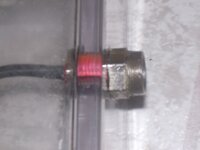
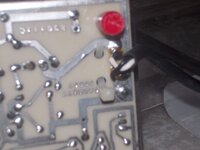
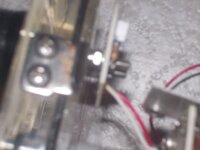
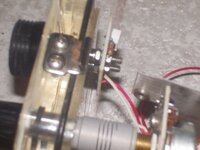
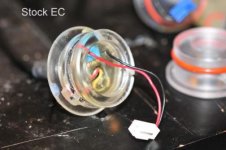
The Sea Hunter is soldered at every point a conductor attaches to the circuit board both from the headphone connector and the coil connector.
The photo of the Excal is a stock one supplied by OBN in a different thread. I am NOT bashing the Excal here...I am simply including the photo to show that, just because a detector is "hard-wired", it does not necessarily follow that the connection is hand soldered. Here we clearly see a push type connection on the Excal.
Last edited:
Boatlode
Bronze Member
- Mar 30, 2014
- 1,728
- 3,034
- Detector(s) used
-
Tesoro Sand Shark......
Nokta Pulse dive....
Scubapro Jet Fins...................
Mares Puck dive computer.......
Sherwood Silhouette BCD.......
Poseidon Cyklon 300 regulator...
- Primary Interest:
- Shipwrecks
The Sea Hunter is soldered at every point a conductor attaches to the circuit board both from the headphone connector and the coil connector.
Of course the wires are soldered - to the board. To my knowledge there is no other way to attach wires to a pcb. And the pcb is sealed inside a waterproof box. This discussion is about the other end of the wires at the coil / box interface. Either you have a connector or you don't.
Also wrong about manufacturing costs. Hand soldering is THE most expensive operation in electronics manufacturing. The labor costs for the hard wiring are way more than the cost of a connector.
This is starting to be funny.
Normally I would have dropped out of this discussion, but I got zapped by a ray yesterday and my foot is really sore and I can't sleep, so I am going to contine.
I think you have come to the realization that the conductors have to be connected to the board...and it is inconsequential whether those conductors come from a removable connection on the bulkhead of the detector...or are the wires coming directly from the coil or headphones. (Incidentally, the wires do not have to be soldered to the board at all. They can be plugged into the board, for instance. They can be fastened to pins on the board with a zip gun. They can even be screwed or bolted to the board...as you can see on the small board behind my Sea Hunter's ikelite connector).
Anyway, to illustrate what an industry standard waterproof "through-hull" or "wire pass through" or "hard wired" fitting actually looks like, here are the fittings on the bulkhead of my White's BHID:
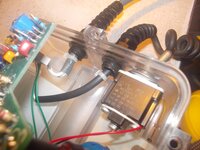
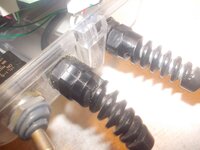
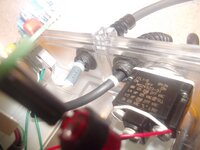
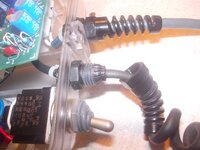
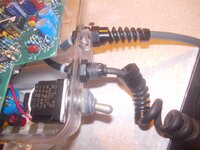
Mounting one of these fittings is no more difficult than mounting a removable connector. In fact, it is easier. There is no soldering involved. You can probably get the idea from the pictures, but I will run down the steps:
The male threaded fitting is placed through one of the holes in the housing and is affixed to the housing chenically or thermally or possibly a combination. On some fitings, there is a "backing nut" behind the male fitting that provides mechanical support.
The coil or headphone wire is threaded through the female or stress releaving fitting (the squiggly part).
The wire is run through the male threaded fitting with enough length to arrive at the PC board and whatever connectors that are going to be used (if any).
The female fitting is tightend down on the male fitting and the pressure exerted by this tightening action compresses the flanges at the top of the male fitting providing a waterproof seal on the wire.
Depending on the rating of the fitting, silicone is sometimes injected into the fitting, mostly as a saftey measure.
A wire tie is placed between the board and the fitting to releive potential pressure on the wire and to keep it from being pulled out.
That's it. Done deal.
Incidentally, I think a fitting of this type wholesales for about .12 cents
By way of comparison, an Ikelite male and female retail for around $40.00.
A manufacturer who bought them by the thousands could probabaly lower this price substantially, but in any case, it would still cost a hell of a lot more than .12 cents.
Now please explain to me how a manufacturer could attach an Ikelite type female connector to the detector housing, wire the female Ikelite connector to the circuit board...and then atttach a male Ikelite fitting to the headphone or coil wire...and do all this more cheaply than the hardwired example I have just showed...
Top Member Reactions
-
 2586
2586 -
 1137
1137 -
 1063
1063 -
 901
901 -
 881
881 -
 846
846 -
 805
805 -
 691
691 -
 638
638 -
 553
553 -
 486
486 -
 480
480 -
 476
476 -
 464
464 -
 461
461 -
O
433
-
 430
430 -
 391
391 -
 380
380 -
 366
366
Users who are viewing this thread
Total: 2 (members: 0, guests: 2)
 (I'm really itching for a new toy. lol)
(I'm really itching for a new toy. lol)




